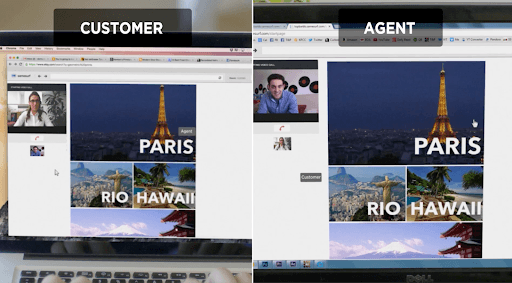Samesurf’s Patented Foundation Makes Agentic AI Truly Autonomous
October 15, 2025

Samesurf is the inventor of modern co-browsing and a pioneer in the development of core systems for Agentic AI.
The rise of Agentic AI marks the most significant shift in enterprise technology since Generative AI. Moving beyond simple automation to true autonomy requires more than powerful Large Language Models; it demands a secure, specialized, and patented infrastructure capable of executing complex web interactions. Samesurf, the inventor of modern co-browsing, delivers this foundation through its Simulated Browsing and In-Page Control Passing technologies.
The Shift from Reactive Tools to Proactive Collaborators
Current AI tools, including standard LLMs, are largely reactive, responding only to prompts or generating summaries. Agentic AI moves beyond this, autonomously perceiving digital environments, reasoning, planning, and executing complex tasks without constant human oversight.
For businesses, this shift is transformative. Agentic AI not only improves efficiency but also boosts operational agility and enables entirely new workflows. AI-enabled devices automate complex processes, deliver personalized customer experiences, and perform sophisticated data analysis that previously required human intervention. For small and mid-sized businesses, Agentic AI provides leverage to scale operations and enhance margins.
The Digital Challenge of Bridging Intelligence and Action
For an AI agent to achieve true autonomy, it must reliably interact with the web, which serves as the primary interface for modern commerce, support, and enterprise software. This requirement introduces a fundamental challenge: how to provide LLM intelligence with a dependable, standardized method for taking action in a highly dynamic and unstructured web environment.
Traditional web automation methods, such as Robotic Process Automation, are notoriously brittle and require constant maintenance whenever a website’s underlying code changes. Legacy collaboration solutions, like remote desktop systems, are invasive, demanding local software installs, granting full system access, and creating significant security and performance risks.
Adding to the complexity is a critical security concern. Web AI agents, due to their structural design for web interaction, are significantly more vulnerable to following malicious commands compared with standalone, isolated LLMs. This risk makes secure enterprise deployment challenging and underscores the need for a controlled execution environment that can neutralize threats proactively. Samesurf’s patented Simulated Browsing, powered by the Cloud Browser, provides this essential infrastructure. By creating a protected environment where the AI-enabled device can perceive and interact with the web like a human user, Samesurf separates intelligence from execution, enabling advanced AI models to operate safely and reliably within high-stakes digital workflows.
Samesurf’s Foundational IP
Samesurf’s leadership in Agentic AI is grounded in its extensive and validated intellectual property portfolio, holding multiple USPTO patents in simulated browsing dating back over a decade, with priority dates as early as May 20, 2010, including patent 9,483,448. The foundational authority of this technology was confirmed when the Patent Trial and Appeal Board upheld all 16 claims of the core ‘448 patent as valid. This long-standing IP foundation provides the stability and authority necessary to build and deploy the next generation of AI-enabled applications for Fortune 100 clients.
Building on this simulated browsing foundation, Samesurf secured two recently issued patents, 12,101,361 and 12,088,647, with priority dates of February 17, 2023, which specifically disclose foundational elements for Agentic AI. These patents formally address the role of autonomous entities within the browsing ecosystem. They define system flows where session participants may include AI-enabled devices alongside human users, confirming that AI agents can “simulate the role of a human user via scripting, customized programming, integration with an artificial intelligence component, or any other simulated medium.”
This formal inclusion of AI agents as equivalent peers within the shared browsing system represents a crucial architectural distinction. It goes beyond external manipulation tools by creating an integrated environment of co-agency, allowing the AI-enabled device to fully inhabit the role of a user. This integrated participation is essential for handling complex, multi-step tasks, such as customer onboarding or technical support, where the AI agent must experience the content flow and context alongside a human participant.
Samesurf’s patents also define the operational architecture required to manage these autonomous interactions. The system relies on the precise role and operation of five critical components: AI-enabled or human host and guest devices, cloud browsers, synchronization servers, encoders, and automated systems that redact sensitive elements using machine learning.
Simulated Browsing and the Cloud Browser Paradigm
Simulated Browsing is the core mechanism that enables AI agents to operate autonomously on the web. Powered by the Cloud Browser, it allows the agent to replicate human navigation and interaction, including clicks and data entry, across single or multiple browser tabs and any form of online content. This Cloud Browser-based approach provides a significant architectural advantage over traditional screen scraping or headless browsing. By processing raw frames and data streams, the system delivers a standardized, high-fidelity representation of content, overcoming graphical fidelity and platform inconsistency issues that often limit legacy automation methods. A key feature that drives rapid adoption is the platform’s code-free and install-free deployment model. Simulated Browsing requires no code placement, client-side installs, or complex IT network modifications, eliminating IT friction and enabling AI agents to reliably navigate web experiences that are not controlled by the deploying company, such as a purchasing agent interacting with a third-party supplier portal. This low-friction deployment, achieved through secure server-side integration via a REST API, is essential for scaling Agentic AI solutions across the enterprise.
Samesurf’s foundational technology ensures true ubiquity for autonomous agents, supporting synchronous, multi-user functionality across any web-enabled device, browser, or system. This capability extends Agentic AI beyond conventional PC-based workflows into the growing ecosystem of AI-enabled devices and the Internet of Things. With support for mobile applications on iOS and Android, as well as generic web dashboards, Simulated Browsing allows AI agents to interact with complex web interfaces on smart devices. For example, an AI agent could securely navigate a smart factory control panel to proactively adjust settings, such as regulating a smart AC system based on real-time temperature telemetry. By operating within a controlled, secure environment and using standard HTTPS ports 80 and 443, the platform avoids the complexity and security risks associated with opening new ports or making network modifications.
In-Page Control Passing for Human-AI Oversight
Autonomy, particularly in high-stakes enterprise applications, must be paired with robust governance. For decision-making AI agents, the ability to observe, supervise, and intervene is essential for ensuring trust and safety. Samesurf’s patents explicitly define interactions where a human “observes, supervises and/or intervenes” via features such as In-Page Control Passing. This patented feature enables non-invasive transfer of navigational control between an AI agent and a human user, or among multiple human collaborators, all within the same web page. Control is passed without relinquishing device control or system access, providing instant, contextual assistance. This allows an AI agent to hand control to a human expert when encountering an unforeseen edge case or system error, without the security and performance risks associated with full remote desktop access.
Unlike traditional automation, where a failure halts the process and requires a human restart, Samesurf’s architecture transforms error handling into a collaborative moment. When an AI agent reaches a roadblock, the Control Passing mechanism instantly transfers navigation to a human supervisor within the exact context of the web page where the issue occurred. This reduces downtime and significantly lowers Mean Time to Resolution, while ensuring the entire supervised session is recorded for audit and compliance purposes. Advanced features like Multi-Leader Mode allow multiple collaborators to interact with content simultaneously without manually passing control. This is critical for complex tasks requiring immediate co-agency, such as a human verifying sensitive credentials while the AI agent completes ancillary fields. By enabling secure, contextual handoffs, Samesurf establishes supervised autonomy as a standard governance layer, making sophisticated AI agents viable in mission-critical enterprise environments.
Achieving Enterprise-Grade Trust
Samesurf’s validated IP and advanced technology make it the essential execution and governance layer for the Agentic Enterprise, translating LLM planning and reasoning into secure, scalable, actionable steps in the digital world. Its competitive moat, built on 15 years of simulated browsing expertise combined with new patents explicitly naming AI agents, protects its position and ensures operational reliability.
The platform’s install-free, code-free deployment via a secure REST API maximizes flexibility and avoids IT friction while allowing enterprises to integrate Samesurf seamlessly into existing digital workflows. By embedding autonomous, patented compliance mechanisms, Samesurf ensures that AI-enabled operations meet legal and regulatory requirements regardless of future policy shifts, focusing enterprise investment on durable and lawful execution.
Samesurf bridges the gap between AI intelligence and autonomous execution through its patented infrastructure. Simulated Browsing gives the AI-enabled agent digital control, while In-Page Control Passing provides essential human oversight. This architecture delivers a secure, cross-platform, and inherently compliant framework, enabling enterprises to deploy complex, supervised AI agents immediately and transition Agentic AI from emerging technology to a trusted, fully integrated operational reality.
Visit samesurf.com to learn more or go to https://www.samesurf.com/request-demo to request a demo today.


